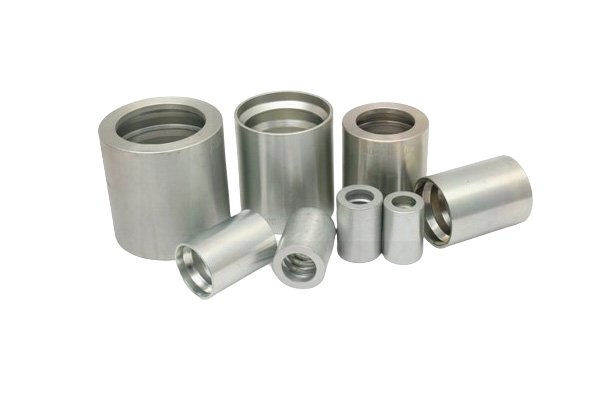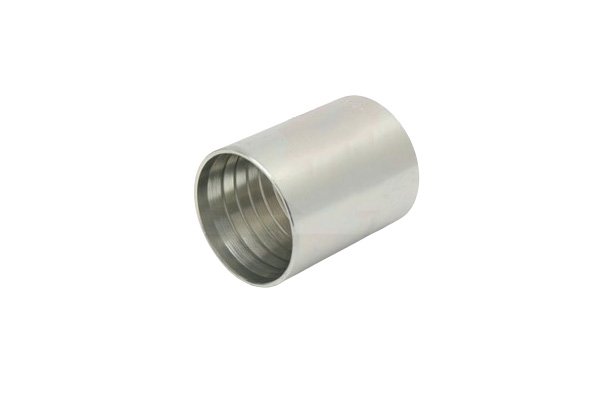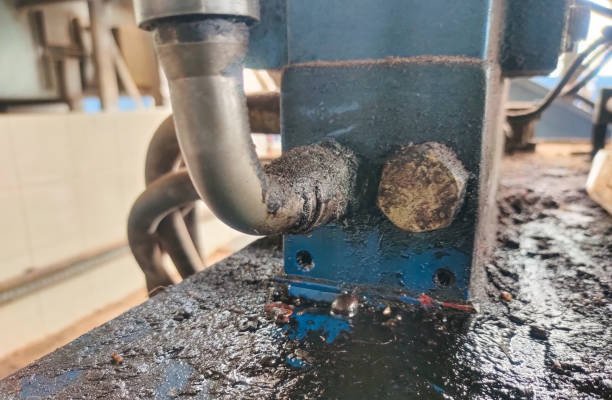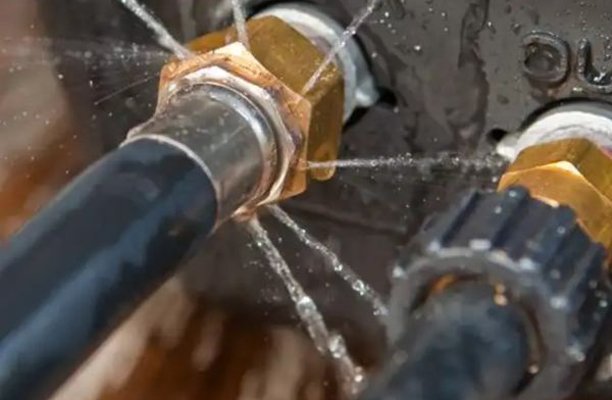In hydraulic systems, selecting the correct hose ferrule is paramount to ensure optimal performance and safety. This comprehensive guide explores the diverse types of hose ferrules, their critical features, and provides expert tips for making informed choices tailored to specific hydraulic needs.
What Is a Hydraulic Hose Ferrule?
A hydraulic hose ferrule is a metal sleeve that reinforces the connection between a hose and its fitting. It is crimped onto the hose, creating a secure and leak-proof bond. Ferrules are essential in hydraulic systems where high pressures demand robust and reliable connections.
Typically made from materials like steel, stainless steel, or brass, ferrules must withstand extreme temperatures, pressures, and environmental conditions. Their primary function is to ensure that hydraulic fluid flows without interruptions, minimizing risks of leaks or system failures.
Importance of Using the Right Hydraulic Hose Ferrule
Selecting the appropriate hydraulic hose ferrule is crucial for several reasons:
- Enhanced Durability: The right ferrule ensures a long-lasting connection, reducing wear and tear over time.
- Leak Prevention: Properly matched ferrules and hoses minimize the risk of leaks, which can lead to equipment damage and downtime.
- Safety Compliance: Adhering to industry standards ensures safe and efficient operations in hydraulic systems.
Choosing the correct ferrule type and material not only optimizes performance but also ensures compliance with safety regulations, ultimately protecting both personnel and equipment.
Different Types of Hydraulic Hose Ferrules
- High-Pressure Applications: Detail the features of ferrules like the 00400 model, which is designed for spiral hoses in extreme environments. Emphasize its capability to handle intense pressures found in heavy-duty applications such as mining and construction.
- Medium-Pressure Scenarios: Analyze ferrules such as the 00110 model, perfect for braided hoses used in medium-pressure settings like agricultural and light industrial applications. Discuss its balance of flexibility and strength.
- Low-Pressure Operations: Describe ferrules like the 00018, suited for low-pressure or pneumatic systems, highlighting its use in less demanding contexts where high pressure is not a factor.
Materials Used in Hydraulic Hose Ferrules
The material composition of hydraulic hose ferrules significantly impacts their performance and longevity. The most commonly used materials include:
- Steel: Known for its strength and durability, steel ferrules are ideal for high-pressure applications. They are resistant to deformation and are widely used in industrial and construction settings.
- Stainless Steel: Offering superior corrosion resistance, stainless steel ferrules are suited for applications in harsh environments, such as marine or chemical industries.
- Brass: Brass ferrules are lightweight and resistant to corrosion, making them a popular choice for less demanding applications, such as automotive or agricultural equipment.
When selecting a ferrule material, consider factors like operating pressure, temperature, and exposure to corrosive elements to ensure optimal performance.
Selecting the Right Hydraulic Hose Ferrule for Your Application
Choosing the correct hydraulic hose ferrule involves evaluating several key factors:
- Hose Type: Ensure the ferrule is compatible with the specific type of hose, whether skive or non-skive.
- Pressure Requirements: Match the ferrule’s pressure rating to the system’s operational pressure to avoid failures.
- Environmental Conditions: Consider temperature extremes, exposure to chemicals, and the presence of moisture when selecting materials and designs.
Additionally, always refer to manufacturer guidelines for compatibility and specifications to achieve a secure and reliable connection.
Hydraulic Hose Ferrule Standards and Compliance
Adhering to industry standards ensures the safety and efficiency of hydraulic systems. Common standards for hydraulic hose ferrules include:
- ISO (International Organization for Standardization): Specifies dimensions, materials, and performance requirements for ferrules used in hydraulic systems.
- SAE (Society of Automotive Engineers): Focuses on design and performance benchmarks for hydraulic components.
- DIN (Deutsches Institut für Normung): Commonly used in Europe, DIN standards define technical specifications for ferrules and other hydraulic components.
Compliance with these standards not only enhances reliability but also ensures the system meets legal and safety requirements in various industries.
How to Properly Install Hydraulic Hose Ferrules

Installing hydraulic hose ferrules correctly is crucial to maintaining the system’s integrity and preventing leaks. Follow these steps for proper installation:
Tools Required for Installation
- Hydraulic hose crimping machine.
- Measuring tools (e.g., calipers) to verify dimensions.
- Lubricants (if recommended by the manufacturer).
Step-by-Step Installation Process
- Prepare the hose by cutting it to the desired length with a clean, square cut.
- Insert the ferrule onto the hose, ensuring it is positioned correctly.
- Fit the hose into the appropriate fitting.
- Use the crimping machine to apply uniform pressure around the ferrule, securing it onto the hose.
- Inspect the assembly to confirm proper alignment and a secure fit.
Common Mistakes to Avoid
- Using an incompatible ferrule or fitting for the hose type.
- Applying uneven pressure during the crimping process.
- Neglecting to verify pressure ratings and specifications.
By following these steps, you can ensure a secure and durable connection that withstands high-pressure environments.
Common Issues with Hydraulic Hose Ferrules and How to Fix Them
Even with proper installation, issues with hydraulic hose ferrules can occur over time. Here are some common problems and their solutions:
Leaks and Improper Sealing
Cause: Incorrect crimping or an incompatible ferrule. Solution: Re-crimp the ferrule using a properly calibrated machine or replace it with a compatible type.
Corrosion and Wear
Cause: Exposure to harsh environments or the use of unsuitable materials. Solution: Opt for ferrules made from corrosion-resistant materials like stainless steel.
Misalignment and Assembly Errors
Cause: Poor installation practices or using mismatched components. Solution: Disassemble the
Innovations in Hydraulic Hose Ferrule Technology
The hydraulic industry continues to evolve, introducing innovative designs and technologies to enhance the performance of hose ferrules. Some of the latest advancements include:
Enhanced Materials
Manufacturers are experimenting with advanced materials, such as composite metals and high-grade stainless steel, to improve durability, corrosion resistance, and weight reduction.
Smart Ferrules
Integrated with sensors, smart ferrules can monitor pressure and temperature in real time, alerting operators to potential issues before failures occur. These are particularly beneficial in critical applications like aerospace and industrial automation.
Eco-Friendly Coatings
Environmentally friendly coatings are being developed to reduce the environmental impact while maintaining superior corrosion resistance. These coatings are especially popular in industries adhering to stringent environmental regulations.
These innovations aim to address modern challenges in hydraulic systems, ensuring enhanced efficiency and reliability.
Cost Considerations for Hydraulic Hose Ferrules
The cost of hydraulic hose ferrules can vary widely based on material, design, and application. Here are some factors to consider when budgeting for ferrule replacements:
Material and Quality
High-quality materials like stainless steel typically cost more but offer better durability and performance. Opting for cheaper materials may result in frequent replacements and higher long-term expenses.
Application-Specific Requirements
Specialized ferrules designed for high-pressure or corrosive environments may have a higher price point but are essential for ensuring safety and reliability in demanding applications.
Quantity and Bulk Purchasing
Purchasing ferrules in bulk often reduces per-unit costs. However, ensure you have adequate storage facilities to maintain their quality over time.
While cost is an important factor, prioritize quality and compatibility to avoid compromising the performance of your hydraulic system.
Top Manufacturers and Suppliers of Hydraulic Hose Ferrules
When selecting hydraulic hose ferrules, choosing a reputable manufacturer or supplier is essential. Some of the leading brands include:
Global Leaders
Companies like Eaton, Parker Hannifin, and Gates are well-known for producing high-quality hydraulic components, including hose ferrules.
Regional Suppliers
Many regional suppliers cater to specific industries and applications, offering customized solutions and competitive pricing.
Key Factors to Consider
- Certifications and compliance with industry standards.
- Customer reviews and reputation for reliability.
- Availability of technical support and after-sales services.
Researching and selecting a reliable supplier ensures access to durable and compatible ferrules, enhancing the overall efficiency of your hydraulic system.
Conclusion
Hydraulic hose ferrules are vital components that ensure the efficiency, safety, and longevity of hydraulic systems. By understanding the different types, materials, and standards, you can make informed decisions to optimize your operations. Whether you’re in construction, agriculture, or industrial automation, selecting the right ferrules can prevent costly downtime and improve overall system performance.
Investing in high-quality ferrules, following proper installation practices, and conducting regular maintenance are key steps to achieving a reliable hydraulic system. Use this guide to navigate the complexities of hydraulic hose ferrules and keep your systems running smoothly.
FAQs
- Q: What is the difference between skive and non-skive ferrules?
A: Skive ferrules are designed for hoses with the outer layer removed, ensuring better contact with the fitting. Non-skive ferrules work with hoses that retain their outer layer, offering simpler installation. - Q: How do I know if a ferrule is compatible with my hose?
A: Check the manufacturer’s specifications for both the hose and ferrule to ensure they match in size, pressure rating, and material. - Q: Can I reuse hydraulic hose ferrules?
A: Reusing ferrules is not recommended as it can compromise the seal and lead to system failure. Always use new ferrules for replacements. - Q: How often should ferrules be inspected?
A: Regular inspections should be conducted during routine maintenance, especially in high-pressure or corrosive environments. - Q: What tools are required to install hydraulic ferrules?
A: Essential tools include a hydraulic hose crimping machine, measuring tools, and possibly lubricants depending on the application.







